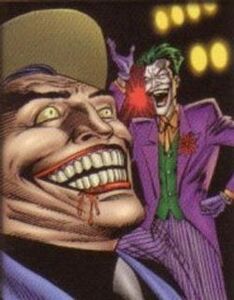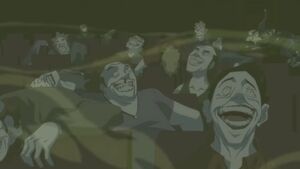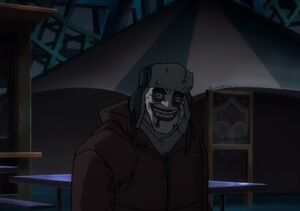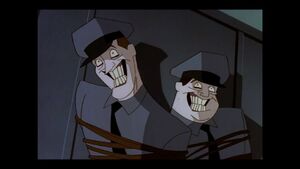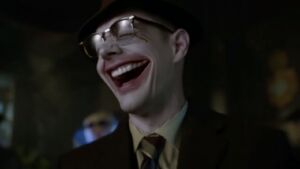The "Joker Venom" is a poisonous toxin and the main murderous signature hidden weapon that was created and used by Batman’s legendary archenemy in the history of Gotham City, the Joker.
Effects
Lethal Version
Contact with the Joker Venom causes uncontrollable spasms of laughter, followed by such painful death. Some have speculated that the toxin hyper–stimulates the laughter functions of the brain, leaving the victim unable to breathe.
Non-Lethal Version
The toxin causes uncontrollable laughter, but instead of dying, their faces are usually pulled into an unusually large grin. Artists often stylize the effects, adding yellowed teeth, bulging eyes, paleness etc. similar to the features of the Joker himself. Prolonged exposure to the non-fatal forms can cause some permanent brain damage.
Uses
Being highly insane and highly intelligent, the Joker had many ways of using the toxin. One particular incident involved using a very similar chemical agent to poison the fish of Gotham Harbor, in an unsuccessful attempt to patent the resulting “Joker Fish”.
Joker venom was administered in several ways, including but not limited to the following:
- Introduced into food or beverages
- Hidden in hygienic products
- Injected into the bloodstream
- Applied to projectiles (bullets or darts)
- Aerosol form (gas, smoke, or mist)
Cure
Batman administers the antidote to one victim G. Carl Francis. Batman was able to develop an antidote for the venom which was usually applied with an injector. This saved many lives, including him on several occasions.
A modified version of the chemicals which transformed the Joker (mixed with a dose of Joker venom itself) turned Jack Ryder into the maniacal hero the Creeper. Fortunately, Batman’s antidote worked on him, though Jack was supposed to constantly wear special antidote “patches” to remain in his old state. Poison Ivy was naturally immune to all toxins and poisons, including the Joker’s.
History
Joker venom has been a part of the Joker’s arsenal since his first appearance in Batman #1. The venom is often deployed as an airborne agent, but can also be used in its liquid form (used both to poison victims through their unwitting consumption of it, or in special darts).
In the original animated series of Batman, on the episode The Laughing Fish, the venom was injected into the fish then passed along into cats to attack the target and administer the venom.
Also in the same episode the venom is administered in two parts, first using perfume, then breathing the gas. In The Killing Joke, Joker uses a spike worn in his palm (similar to his Joy Buzzer) to administer the drug in a handshake.
In “Batman: The Man Who Laughs”, the Joker uses bullets laced with Joker Venom in order to kill another of his selected targets. In Jeph Loeb’s and Tim Sale’s “Catwoman: When in Rome”, Joker venom is duplicated by the Riddler to blame Catwoman for the murder of a Sicilian Mafia kingpin. It is referred to as Joker Juice by both Catwoman and The Riddler.
When someone is to breathe in Joker Gas, it kills them while giving it’s victim a vicious, sardonic smile on his/her face. There were many variations of Joker gas, and it also affects animals, such as cats, squirrels and fish. Joker venom can exist in liquid and gas states and has been used to a great effect.
The gas form is slightly denser than air and in some portrayals dissipates over time. The effects are similar to the legendary Sardinian Cabbage which supposedly causes laughter until the point of death.
In a 1980s comic book, the Joker facilitates one of his many escapes from Arkham Asylum using the venom - by mixing together the common cleaning chemicals found in a janitor's closet, showing his vast knowledge of chemicals yet again.
The DC Technical Manual: S.T.A.R. Labs 1993 Annual Report (a sourcebook for Mayfair's DC Heroes Roleplaying Game) stated that Joker Venom is a hellish mixture of hydrogen cyanide and Strychnodide (a strychnine derivative), the toxin causes immediate cessation of heart and brain functions.
As a side effect, the victim’s muscles contract in such a way as to severely tighten and discolor the victim’s skin, especially in the facial area. This leaves the victim’s corpse permanently scarred with a clown-like grin in tribute to his killer.
Since the Joker Venom is just as deadly if absorbed through the pores as it is if inhaled, the Joker occasionally releases it in gas form throughout the central heating/cooling vents of a building.
How exactly Joker knows how to make the venom varies by story. In the graphic novel “Batman: The Killing Joke”, it was revealed that the man who would become the Joker once worked in a chemical plant, and may have had some chemical education as a result.
The 2004 graphic novel “Batman: The Man Who Laughs” revealed that Joker, who was created by falling into a vat of chemicals, had stolen them in a plan to poison Gotham City’s reservoir, but the plan was foiled by Batman. His brand of Joker venom turns the victim’s skin white, hair and nails green (though he's been known to paint them red & black) and lips become ruby red.
However, it appeared he went through stages to get the desired effect when the Police discovered a warehouse full of dead bodies all with white skin and green hair but on some the face muscles were so contracted that the eyes popped out and the skin tore apart.
The perfected joker venom came in two varieties: a fast acting one used to kill a T.V reporter and a slow acting one to kill one of his victims at exactly midnight. Another kind of venom, as shown in an episode in The Batman, The Laughing Bat was a kind of venom which affects the victim’s nervous system and causing them to break into fits of uncontrollable laughter, which would slowly kill them throughout a prolonged period of time.
A story arc in “Batman: Legends of the Dark Knight” revealed that a cousin of the man who became the Joker, Melvin Reipan, an autistic savant with a gift for chemistry, is persuaded to create the Joker Venom as a way to “make people laugh”, in exchange for becoming “handsome”. However, Reipan is in fact physically very attractive, only having been told by his abusive mother he was ugly.
This story appeared in Batman: Legends of the Dark Knight #50 and not only revealed the origins of Joker Venom, but also told the first battle between Batman and the Joker after his first attempt to destroy the city.
In the story arc, Batman: Cacophony, a gang war between the Joker and Maxie Zeus erupts over Maxie Zeus cutting the Joker’s venom with Ecstasy to make a new designer drug called “Chuckles”.
Marvel Comics has an apparent equivalent to Joker venom in the form of Red Skull’s “Dust of Death”, a chemical which turns the head of its victim into a “red skull” resembling that of Red Skull.
In a crossover, the Red Skull and the Joker face off against one another, the Joker got angry when he learned that he had unwittingly worked for a Nazi (“I may be a criminal lunatic, but I'm an American criminal lunatic!”), and employ their favorite toxins on each other.
They realize the toxins are useless against each other, as both combatants are immune to their own, and both toxins are strikingly similar at a chemical level.
Appearances In Other Media
Batman: The Animated Series
The Joker venom is used frequently in the animated series, and it’s spin–offs such as “Batman: Mask of the Phantasm”. The most popular use of it in the animated series is through a “Very Special Flower” on The Joker’s purple suit.
In “Batman Beyond: Return of the Joker”, The Joker used this on an elderly Bruce Wayne after ambushing him at the Batcave. During the series the non-lethal version was more often used, due to the fact this was a children’s program. Though the lethal version was occasionally used, with the victims often getting an antidote in time.
The Batman (comics)
Both versions of the venom are used in this series. The non-lethal version is weaponized as a gas and seems to dissipate over time. The gas is called “laughing gas”, and puts its victims into a coma. Batman provided an antidote to this laughing gas. However, Joker also has a lethal version which is a liquid.
The effects of this venom are the same as the one used in the Joker’s first appearance in the comics (the venom which takes 24 hours to kill).
In the meantime, the victim slowly has increasing bouts of uncontrollable laughter until they are unable to breathe and die with Joker’s trademark grin. Batman was once infected with the venom, but was able to create a cure before it was too late. Penguin was infected as well but was cured. The lethal venom is also explosive, as shown in “The End of the Batman”, where Wrath and Scorn fall victims to it. However here it’s not used to kill them but instead is used to break their minds so as not to reveal Batman’s identity, and therefore spoil Joker’s fun.
Batman (1989 film)
The Joker uses “Smylex” specifically in gas form, in an attempt to kill everyone at a celebration in the center of Gotham. He also contaminates household products with binary compounds of the chemical, which is only lethal when mixed together the right way.
The Dark Knight
Joker Venom made no overt appearances in The Dark Knight, but the Joker’s preferred method of murder by carving Glasgow smiles into the faces of his victims and applying make–up similar to his own might be a subtle reference. Additionally some theorize that the gas grenade stuffed in the Manager of Gotham National Bank's mouth contained Joker Gas and not harmless smoke.
The Dark Knight (novel)
Shortly after The Joker has first met the crime lords, Sal Maroni hires a private investigator, named Hamlin, to discover who the Joker is. Several weeks later, Hamlin comes back to Maroni completely disheveled and asks if Maroni didn’t just imagine Joker, because there is nothing on him, like he came out of nowhere.
Then Hamlin begins laughing hysterically and dies in the middle of a restaurant. Maroni finds out Hamlin had been poisoned by some herb from out in “China, Tibet, Korea, one of those places” (he’s indifferent to remembering where exactly). It’s also implied in this scene that the Joker venom was derived from the same plant that Scarecrow’s Fear Toxin was made from, as the Toxin was derived from a Blue Poppy in Tibet
Batman: Arkham Asylum
Joker Venom (referred to in the game as “Happy Gas” by the Joker, “Smilex” by the canisters and “Joker Toxin” by others) appears as an obstacle in many areas, and often has to be removed somehow before Batman can proceed. Falling into the gas can be deadly, if the player does not hit the “escape” button fast enough. Joker Toxin in “Batman: Arkham Asylum” attacks the nervous system of its victims, causing a slow, painful, death. The toxin is also very dense, and sinks to the floor, however, allowing would–be victims to climb to a higher point of safety.
The Joker raided the Decontamination Chamber of Arkham with canisters of the toxins, pumping it into the room, killing ten Arkham guards and several of his own men in the process. Three guards and an inmate managed to climb to safety, and were quickly rescued by Batman, who knocked out the inmate to keep him out of trouble. Batman then found that the gas had overcome those trying to operate the extraction system, which would ventilate the toxins out of the room.
The area was sealed off after the toxins were detected, but was re-secured after Batman destroyed the extraction system fuse box with a batarang, triggering ventilation fans to filter the deadly gas out of the room.
The Joker also attempted to pump it into the Medical Facility’s Patient Observation Room to kill Stephen Kellerman, an Arkham doctor, and security guard Aaron Cash, trapping one of his own men inside as well. Cash and Kellerman succeeded in surviving the attack by barricading themselves in an airtight room, allowing enough time for Batman to arrive and get rid of the toxins.
Uncharacteristically, Batman did so by deliberately exposing another person to mortal peril, dropping an inmate onto a weak ceiling to break it, though he acted quickly to vent the room and prevent the man from succumbing to the gas.
Later on, Joker started to attach some cylinders of the gas into several security controls in the Botanical Gardens, the Intensive Treatment and in The Caves when Joker planned to pollute Gotham River with the Titan waste products, if Batman failed to correctly hack the security panels the gas canisters were attached to the room he was in would be pumped full of the gas.
Gallery
Images
Videos
Trivia
- Joker Venom has also been used in other capacities. Maxie Zeus was known to have diluted it and mixed it with Ecstasy, marketing it as a drug called “Chuckles” which became popular at raves. Times Magazine referred to Chuckles as the worst drug epidemic since Crack in the late 1980s.
- The Tim Burton–Joel Schumacher Batman movie franchise refers to it as Smylex, which is the name later given to a brand of toothpaste in the Tim Burton–directed film Charlie and the Chocolate Factory.

